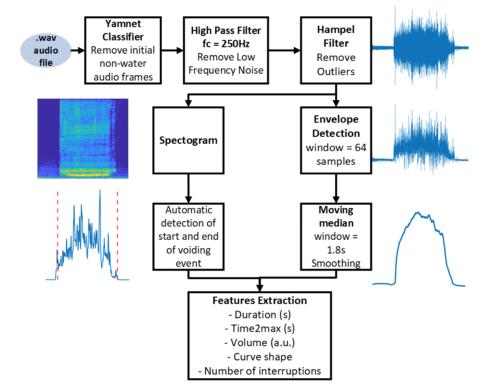Diagnosis of urinary disorder by recording the sound of news pee with a smart watch
The acquired sound is transferred from a smart watch to a PC wirelessly

It's a non -invasive platform.[Image] Urine flow measurement is performed by recording the sound generated when the user interface excretion of the UROSOUND application collides with the water accumulated in the toilet bowl with the internal microphone of the smartwatch.It enables 24 -hour measurements at home and on the go, such as urination, urination time, and number of suspensions, and is more useful in judging diagnosis, treatment, and pathology of urinary disorders (lower urinary tract dysfunction).You can get objective information.Many people develop an overactive bladder who suddenly urinates with aging and wants to go to the bathroom many times.One of these diagnosis of urinary disorders is the urine dynamic test.Observing the state when urinating, examining the function status of the bladder at this time, etc., is useful for diagnosis and treatment.Urine flow patterns, urinary speeds, urination hours, urination, etc. can be evaluated as parameters, and can be objectively shown to the degree of prostate hypertrophy, overactive bladder, urinary incontinence, and neurological bladder.However, this test requires a special test device consisting of a simple toilet or the like, so the person must go to a hospital or clinic and urinate to the test device.It is also known that the patient's situation stress affects the flow, which causes a large variation for each test.As an alternative approach that is easily measured at home without stress, urine flow measurement using sound is considered.This is to clarify the characteristics of the urine flow pattern by capturing the sound generated when the urine flow reaches the water level in the toilet bowl.It is conceivable to install a test instrument in the toilet or a method of catching it in the sound system of a smartphone, but the former cannot be measured outside the portability, and the latter must be measured while holding the smartphone out of the pocket.None of them are the best ways.This time, we adopted a smartwatch near the time of urination, always worn on the patient.Smart watches do not need to be taken out of pockets, and can be recorded easily at home or on the go, both day and night.The proposed platform consists of a developed UROSOUND application that uses a smartwatch to excrete the sound at the time of excretion, and a processing system for extracting urinated parameters from the recorded acoustic signals.The acquired audio file is wirelessly transferred from the UROSOUND application to the remote web server via Wi-Fi, and the characteristics are extracted.Since sounds other than urination become noise, it is classified and silent using a deep learning model.The information to be extracted includes urination time, urination volume, number of suspensions, and changes in urinary volume.Detailed measurements in detailed units by existing urine dynamic tests are difficult, but there are many advantages, such as detecting changes in urination shape and analysis between day and night.This study compared the audio functions of different commercial smartwatches (SUUNTO 7, Fossil Gen 5e, OPPO, TICWATCH C2+, TicWatch E, AppleWatch Series 5).As a result, in order to measure urine flow with sound with a smartwatch, a Smart that automatically adjusts the audio so that the calibration of the amplitude does not cause a constant volume is introduced.It turned out that it was necessary to choose a watch.In the experiment, OPPO's smartwatch was used for three days and evaluated.The reason for choosing a smartwatch made by OPPO is that it is not equipped with the AGC function and that it has a good battery and low price.The wearer controls the UROSOUND app by buttons and touch operations to the smartwatch, and performs a series of tasks, such as recording, stopping, saving, and deleting.Before the start of the exam, the charging was 100 %, and after the recording for 72 hours, the battery level reached 30 %.Under this situation, the average of 6 times a day was successfully recorded for 40 seconds, respectively.It also succeeded in extracting relevant urinary parameters from the sound collected by the proposed processing system.The audio files recorded in this test require 22MB storage and are significantly less than the total storage capacity of commercially available smartwatches.These results have demonstrated that in OPPO smartwatches, urinating sounds can be recorded for three consecutive days without charging, and data can be converted to data from extracted urinated parameters.The research team uses smartwatches for evaluation such as urination disorders, eliminating the waste of time and resources in rural areas and developing countries that are particularly difficult to access urology specialists.He wants to lead to the potential of remote care that can realize health care at home.Source and Image Credits: L.Arjona, L.Enrique Diez, A.Bahillo Martinez and A.Arruza Echevarria, “UroSound: A Smartwatch-based Platform to Perform Non-Intrusive Sound-based Uroflowmetry,” in IEEE Journal of Biomedical and Health Informatics, doi: 10.1109/JBHI.2022.3140590.* Mr. Yuki Yamashita, who presides over the web media "SEAMLESS", introducing the latest research on technology.Mr. Yamashita picks up and explains a highly new nature paper.
ITMEDIA NEWS
最終更新:ITMEDIA NEWS